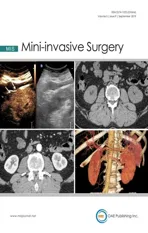Advances in the minimally invasive management of gastric and esophagogastric junction cancer
2019-12-30
Department of Gastroenterology and Minimally Invasive Surgery, Juntendo University Hospital, Tokyo 113-8421, Japan.
It is a great honor and pleasure to act as guest editor for this special issue where many of these key international opinion leaders have generously contributed to help coalesce the goal for the topic of advances in the minimally invasive management of gastric and esophagogastric junction (EGJ) cancer.
Gastrointestinal (GI) cancers are aggressive diseases and ranks the most common diagnosed cancer and death causes worldwide[1].Surgical resection with lymph node dissection (LND) is still the only potentially curative therapy.Minimally invasive surgeries including laparoscopy and robot are widely used in the treatment of GI cancers.
The operation procedures for gastric cancer base on the location of tumor and include distal, proximal or total gastrectomy.Introduction of laparoscopic gastrectomy (LG) has shown promising results and therefore gained popularity worldwide.Van den Berget al.[2]outlined the current state of LG for gastric cancer and its future perspective.Laparoscopic LND is preferred for early gastric cancer now[3].However,the safety and oncologic validity for advanced gastric cancer (AGC) are still being debated.Some clinical trials have been gradually performed focusing AGC treated by LG recently and reported no inferior shortterm outcomes compared with open surgery[4].Shimadaet al.[5]discussed the clinical indications and limitations dealing with LND for AGC, and also the technical tips.LG may be not suitable for all AGC patients, but the role for AGC cannot be underestimated.The authors also discussed the value of LND combined with neo-adjuvant chemotherapy, conversion surgery and other treatments.It is believed that after the long-term outcomes of many ongoing large-scaled phase III trials released in the near future, we can get more powerful evidences.As society ages, older gastric cancer patients are increasing.It is indicated that age may be an independent predictor of increased morbidity and mortality.Few studies about older gastric cancer patients are reported and even fewer on older patients with AGC.Yuuet al.[6]reported their study to show elderly patients with AGC may benefit from laparoscopic distal gastrectomy (LDG).
More and more GI reconstruction can be performed intracorporeally especially in LDG.Ohmuraet al.[7]reported a new reconstruction method named hemi-hand-sewn (HHS) technique.The HHS technique combines linear stapler in posterior wall with hand sewn in anterior wall to create Billroth-I anastomosis.They reported the better surgical results with HHS in comparison with extracorporeal total hand-sewn.An optimal technique of digestive tract reconstruction after distal gastrectomy has not yet been consensus.Zhang and Fukunaga[8]describe the different Billroth-I reconstruction techniques that can be proposed after total LDG.As mentioned by the authors, the ideal reconstruction should be not only for doctors but also for patients.From the review article, readers can understand that the developing reconstruction techniques covering from using hand-sewn anastomosis, circular stapler to linear stapler method, which reflect the wisdom of the surgeon and the pursuit the minima invasive to patients.
There has been a recent increase in the use of totally laparoscopic total gastrectomy (TLTG) for gastric cancer.TLTG usually needs higher laparoscopic techniques and longer learning process.Mazzolaet al.[9]reported their results of TLTG.Their results showed TLTG was a feasible and safe option in the treatment of gastric cancer.
Robotic surgery for gastric cancer is a relatively new research field.With high-resolution three-dimensional and articulated devices, surgeons are able to perform difficult techniques more comfortably and meticulously.Makuuchiet al.[10]reviewed the development of surgical robotics, and describe the advantages and disadvantages of robot gastrectomy for gastric cancer compared to LG.Although robotic gastrectomy has theoretical advantages over LG, evidences are still lacking.Well-designed prospective randomized controlled trials are needed and awaited to obtain conclusive results on this issue.
The incidence of EGJ cancer has shown an upward trend over the past several decades both in the West and East[11].The management is challenging and there is no one-size-fit-all strategy[12].Siewert classification is the standard classification for EGJ cancer.Surgery remains the fundamental treatment and a lot of detail during surgery are reported recent years.Oo and Ahmed[13]discussed the epidemiology, risk factors and the management of EGJ tumors.Readers can get the general of this disease from this review article.Shibaoet al.[14]introduced minimally invasive approach for EGJ cancer and listed evidences for various surgical strategies.The authors discussed different technique according to Siewert type classification and listed advantages and disadvantages.
Most studies focus on Siewert type II cancer, since it is considered the true EGJ tumor.The treatment for type II cancer is still debated.Li and Zang[15]focused on the surgical strategies for type II EGJ cancer in recent year.The Ivor Lewis esophagectomy is the universally accepted technique to resect cancers situated in the middle and distal esophagus and EGJ.de Pascaleet al.[16]and Parthasarathiet al.[17]introduced their experiences and results of totally minimally invasive Ivor Lewis (TMIIL) esophagectomy.Both of their results showed better surgical outcomes in TMIL esophagectomy.
All of published articles are well written and meaningful.Articles published in this present special issue have highlighted the outline of minimally invasive management of gastric and EGJ cancer.We can study al lot from these studies.In the future, still a lot need to be researched and higher evidences are needed to support the conclusions.
DECLARATIONS
Authors’ contributions
The author contributed solely to this preface.
Availability of data and materials
Not applicable.
Financial support and sponsorship
None.
Conflicts of interest
The author declared that there are no conflicts of interest.
Ethical approval and consent to participate
Not applicable.
Consent for publication
Not applicable.
Copyright
© The Author(s) 2019.
